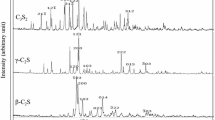Abstract
Microwave energy as a fast technique was utilized for the preparation of calcium silicate hydrates using hydrothermal reaction of silica quartz and/or silica fume with active lime in a solution. The silica/lime ratio was selected to be 60/40 in a mix as compared with the composition of sand-lime-based construction industries. The CSH formation was assessed after treatment at 140 and 160 °C under saturated steam microwave hydrothermal conditions. Moreover, the CSH formation was studied at 160 °C for periods up to 180 min. The prepared samples were characterized through XRD and FTIR. Further, DSC and SEM tools were used to investigate selected samples. The results led to the conclusion that the complete reaction of lime with the available silica sand was pronounced for samples prepared under saturated steam at 160°C/2 h, forming cross network needle structure morphology as seen from SEM results. Moreover, the results confirm the conversion phenomenon of CSH compounds changing in reaction time or in reactive silica percentage into another form of CSH. An amorphous structure like tobermorite is formed in samples containing silica fume as source of silica and microwave hydrothermally cured at 160 °C/2 h.
Similar content being viewed by others
References
El-Hemaly, S.A.S., Taha, A.S., Tawfik A.: Influence of some industrial waste by-products on the properties of the aerated blocks. Egyptian J. of Applied Sci. 21 [4A] (2006) 99–108
Tawfik, A., Taha, A.S., El-Hemaly, S.A.S., El-Didamony, H.: Influence of the Autoclaving Conditions on Some Properties of Lightweight Building Blocks. Silic. Indus. 72 (2007) [5–6] 89–94
Tawfik, A., El-Hemaly, S.A.S., El-Sokary, T.M.: Assessment of Autoclaved Aerated Concrete Samples Incorporated with Cement Kiln Dust within the Raw Materials. Amer. Soc. of Civil Engineers (ASCE), 6th International Engineering and construction Conference (IECC’6) of Advances in Affordable Housing & Green Construction, Cairo, Egypt, (2010) 171–179
Tawfik, A., Soltan, A.M., El-Hemaly, S.A.S., Abd-El-Raoof, F.: Marble Stone Waste as Raw Material for Autoclaved Sand-Lime Bricks. Interceram 61 [3] 96–100
Gabrovšek, R., Kurbus, B., Mueller, D., Weiker, W.: Tobermorite formation in the system CaO, C3S-SiO2-Al2O3-NaOH-H2O under hydrothermal conditions. Cem. Concr. Res. 23 (1993) 321–328
Wu, J., Zhu, Y.J., Chen, F.: Ultrathin calcium silicate hydrate nanosheets with large specific surface areas: synthesis, crystallization, layered self-assembly and applications as excellent adsorbents for drug, protein, and metal ions”. Small 9 [17] (2013) 2911–2925
Xiaoxuan Guo, Zhiqiang Wang, Jin Wu, Yun-Mui Yiu, Yongfeng Hu, Ying-Jie Zhu, Tsun-Kong Sham: Tracking Drug Loading Capacities of Calcium Silicate Hydrate Carrier: A Comparative X-ray Absorption Near Edge Structures Study. J. Phys. Chem. B 119 [31] (2015) 10052–10059
Guan, W., Jin, F., Fang, Z., Fang, D., Cheng, Y., Yan, P., Chen, Q.: Low hydrothermal temperature synthesis of porous calcium silicate hydrate with enhanced reactivity SiO2. Ceram. Internat. 40 (2014) 4415–4420
Masahiko Saigusa, Akiko Yamamoto, Kyoichi Shibuya: Agricultural Use of Porous Hydrated Calcium Silicate: Effect of porous hydrated calcium silicate on resistance of rice plant (Oryza sativa L.) to rice blast (Pyriculariaolyzae)”. Plant Prod. Sci. 3 [1] (2000) 51–54
Ping Yu. R., James Kirkpatrick, Brent Poe, Paul F. McMillan, Xiandong Cong: Structure of Calcium Silicate Hydrate (C-S-H): Near-, Mid-, and Far-Infrared Spectroscopy. J. Amer. Ceram. Soc. 82 (1999) [3] 742–748
Baltakys, K., Jauberthie, R., Siauciunas, R., Kaminskas, R.: Influence of modification of SiO2 on the formation of calcium silicate hydrate. Mater. Sci-Poland 25 [3] (2007) 663–670
Ray, A.: Hydrothermally treated cement-based building materials — Past, present, and future Pure. Appl. Chem. 74 [11] (2002) 2131–2135
Rouhollah Alizadeh, Laila Raki, Jon M. Makar, James J., Beaudoin, Igor Moudrakovski: Hydration of tricalcium silicate in the presence of synthetic calcium-silicate-hydrate. J. Mater. Chem. 19 (2009) 7937–7946
Ramachandran, V.S.: Application of differential thermal analysis in cement chemistry. VII. Autoclaved cementitious products. Chemical Publishing Company Inc., New York (1969)
Author information
Authors and Affiliations
Corresponding author
Rights and permissions
About this article
Cite this article
Tawfik, A., El-Raoof, F.A., Youssef, H.F. et al. Microwave Hydrothermal Assessment for CSH Formation in Silica-Lime-Water Systems. Interceram. - Int. Ceram. Rev. 66, 82–89 (2017). https://doi.org/10.1007/BF03401203
Received:
Published:
Issue Date:
DOI: https://doi.org/10.1007/BF03401203




